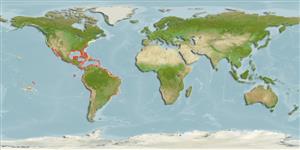Classificação / Names
Common names from other countries
Referência principal
Tamanho / Peso / Idade
Max length : 104 cm TL macho/indeterminado; (Ref. 7251); Peso máx. publicado: 10.0 kg (Ref. 37955)
Length at first maturity
Lm 48.8, range 21 - 36 cm
Ambiente
; marinhas; estuarina associadas(os) a recifes; anfídromo (Ref. 51243); intervalo de profundidade 0 - 84 m (Ref. 13608), usually 1 - 15 m (Ref. 9268)
Clima / Intervalo
Subtropical, preferred 26°C (Ref. 107945); 45°N - 31°S, 159°W - 35°W (Ref. 55166)
Distribuição
Worldwide in warm seas. Hawaiian species have been verified by electrophoretic analysis (Ref. 5577), hence, Albula vulpes might be further split. Eastern Pacific: California, USA to Peru (Ref. 2850). Western Atlantic: North Carolina, USA to Florida, Bahamas, Gulf of Mexico, Antilles and Caribbean to Brazil (Ref. 26938). Northwest Atlantic: Canada (Ref. 5951). The West African form is Albula goreensis, Valenciennes, 1846.
Países | Áreas FAO | Ecossistemas | Ocorrências | Introduções
Descrição breve
Espinhos dorsais (total): 0; Raios dorsais moles (total): 15-19; Espinhos anais 0; Raios anais moles: 7 - 9; Vértebras: 69 - 74. Branchiostegal rays 12-14 (Ref. 4639). Silvery with dusky fins; base of pectorals yellow (Ref. 3970). Body elongate and fusiform (Ref. 4832). Last ray of dorsal and anal fins not prolonged; head region naked; spot and band absent on head; margin of nasal pore not black (Ref. 13608). Bluntly conical snout extends beyond inferior mouth (Ref. 26938). Pectoral and pelvic axillary scales present; a single long scale on each side of membrane between each ray of dorsal and anal fins (Ref. 4832).
Categoria na Lista Vermelha da IUCN (Ref. 115185)
Ameaça para o homem
Reports of ciguatera poisoning (Ref. 4690)
Utilização humana
Pescarias: pouco comercial; peixe desportivo: sim; isco: usually
Mais informação
ReferênciasAquaculturaPerfil para aquaculturaEstirpesGenéticaFrequência dos alelosHereditariedadeDoençasProcessamentoMass conversion
Ferramentas
Relatórios especiais
Descarregue XML
Fontes da internet
Estimates of some properties based on models
Phylogenetic diversity index
PD50 = 0.5007 many relatives (e.g. carps) 0.5 - 2.0 few relatives (e.g. lungfishes)
Nível Trófico
3.7 ±0.3 se; Based on diet studies.
Resiliência
Baixo, tempo mínimo de duplicação da população 4,5 - 14 anos (K=0.3; tm=2; tmax=20)
Vulnerabilidade
Moderate vulnerability (43 of 100)
Categoria de preço
